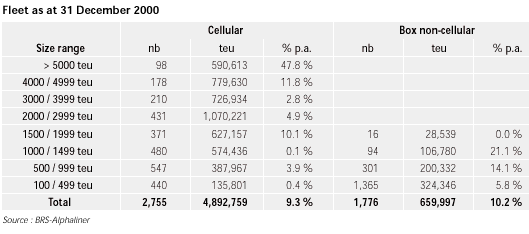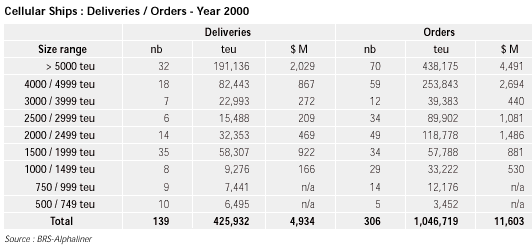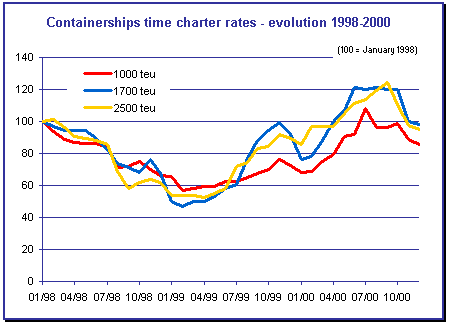
The Containership market
in 2000 |
|
The fleet
The charter market
- ships over 3,000 teu
- ships of 2,500/3,000 teu
- ships of 2,000/2,500 teu
|
|
- ships of 1,500/2,000 teu
- ships of 1,250/1,500 teu
- ships of 1,000/1,250 teu
- ships under 1,000 teu
The containership second-hand market
|
|
|
|
| The Fleet |

|
|
The cellular fleet doubled during the past seven
years, in teu terms. At 31 December 2000, there were 2,755 cellular
ships aggregating 4,900,000 teu. The annual progression stands at 9.3 %
during 2000. In 1999, an increase of only 5.1 % was observed,
contrasting strongly with the 10-15 % annual rises registered in the
years 1995-1998.
The cellular fleet amounts to 71.3 % of the overall
teu capacity, which totals 6,860,000 teu. This figure was only 55 % ten
years ago. The fleet of multipurpose "box shaped" cargo
vessels provides a further 660,000 teu, representing 9.6 % of the total
teu capacity (up from 7.9 % ten years ago). Conventional cargo vessels,
roro ships, conros, conbulkers and reefer ships share the remaining 19 %
of the capacity.


139 cellular ships were delivered in 2000, for
426,000 teu. Fifty ships of 4,000 teu and above, all dedicated to the
East-West trades provided 64 % of this capacity. Most of these large
ships were delivered during the second half of the year. These massive
deliveries triggered off a cascade effect, which, at the end, left
several ships of 1,200 / 1,800 teu without employment.
The orderbook rose strongly during 2000, with further
commitments for 6,000+ teu ships and a wave of orders for Panamax
tonnage and for 2,500 teu ships. There were 306 cellular ships on order
for 1,046,719 teu as 31 December 2000. During 2000, only 16 cellular
ships were scrapped and another two converted or lost, for a total of
18,959 teu.
According to our estimates, the combined value of
ships of 1,000 teu and more ordered during 2000 stands at $ 11.6 bn. By
comparison, the ships delivered had a combined contractual value of $
4.9 bn.
Newbuilding prices increased like other types of
ships all through the year, and owners who launched their newbuilding
programs in 1998 won a 'bonus' on their future daily running costs.
This will help, in the event of a turnaround in the market.
As owners feared further price increases, they
ordered ships by batches. All types of ships were affected. However,
large container ships of 5,000+ teu were not ordered at the same levels
as in the previous year. This is good news for owners of chartered
tonnage as massive ordering of large container ships is raising some
worries.
These price rises combined with a depressed euro is a
bonus for European yards. The 15 % slide of the euro against the US
dollar during the past 12 months has helped especially German yards to
fill their orderbook and bring them near their Asian counterparts in
terms of berth occupancy.
Very Large Container Ships (VLCS) of 9,000 teu and
more are now viewed as a serious option. Several operators consider
VLCSs. Maersk-SeaLand appears as the leading line with such ships,
possibly around 12,000 teu (they could be built by APM's Odense yard).
P&O Nedlloyd plans to order 10,000 teu ships. China Shipping Group
is considering 9,000 teu ships. Other leading operators are also
studying the possibility to invest in 8,000 / 10,000 teu ships.
Most of the pure reefer ships built during the past
decade are fitted to carry containers on deck and, in some cases, under
deck. Our count shows that 178 of them offer an intake above 100 teu,
for a total of 44,000 teu. This represents a mere 0.6 % of the total teu
fleet. This share has remained about the same over the years (we had it
at 18,300 teu in 1992, on 78 ships).
It is worth noting that less than 15 % of the 428,000
teu conbulker fleet is operating on conventional liner markets
(including mixed operations, but excluding regular parcel trades). In
2000, several conbulkers of 1,300 / 2,000 teu were regularly employed on
pure container trades because of the cellular tonnage shortage.
|
| The charter market |

|
|
The year 2000 started bullish and is finishing on a
bearish trend. Rates reached their peaks in September. Rates doubled on
the average since the lows of the spring 1999. However, some sizes
benefited more than others, with larger ships performing better than
smaller ones. This rise can be explained by two factors : the seaborne
container trade enjoyed a boom and deliveries of ships were at a low
ebb, especially during the first three quarters of the year.
At mid-year, there were a shortage of 1,500 / 3,000
teu ships (and of Panamaxes as well). Charterers had difficulties to
find substitutes, especially for long periods.

After a peak during the summer, rates started to
decline in October, at least for medium-sized ships. The prompt
availability of several ships in the 1,200 / 1,800 teu range during the
fourth quarter has driven rates down. This decline can be explained by a
convergence of adverse causes.
- Acceleration of deliveries of 5,000+ teu tonnage in
the second half of the year. This induced a cascade effect that hit
medium-sized ships of 1,500 teu (+/- 300 teu) more than other
categories.
- Operators such as Evergreen / Uniglory, COSCO and
Cheng Lie continued their policy of chartering out their own tonnage
(especially in the 1,400 / 1,700 teu bracket).
- The takeover of Norasia Line by CSAV in June, led
to rationalisations and a significant reduction of the combined fleets.
Before the deal, both fleets ran a total of 69 ships for 114,000 teu,
six months after, the combined fleet stood at 54 ships for 97,000 teu.
This means that about 17,000 teu of chartered tonnage went back on the
market during the second half of the year. The reduction was shared
about 50 / 50 between Norasia and CSAV units.
- The FESCO and Great Western Shipping Line regrouping on the
Pacific (in November) led to the disposal of four 1,500 teu ships.
- Active operators of the first half of the year, such as China
Shipping or CMA-CGM, were quieter thereafter, although they were
relayed by K Line and Sinotrans but on a more modest scale.
It is also worth pointing out that the fleet
increases observed in 2000 by major carriers matched almost perfectly
with the materialisation of newbuilding programs (owned or long-term
chartered), which of course lessen the needs for short / medium-term
chartered tonnage. The Maersk-Sealand-Safmarine's fleet rose by 74,000
teu over the year, with the delivery of twelve ships totalling 76,000
teu. Internal growth at P&O Nedlloyd (obtained after the exclusion
of the impact of Farrell Line and Harrison buying) stood at 50,000 teu,
with the delivery of 13 ships for 56,000 teu. Conversely, the growth of
15,000 teu of the CMA-CGM fleet involved chartered tonnage only.
Most shipyards are fully booked until early 2003, and
even until end 2003 for some of them. One must go back to 1972-1973 to
find such a healthy orderbook, although it was at that time heavily
dominated by VL/ULCCs and the bubble burst out in the wake of the
October 1973 oil crash. The current orderbook is better balanced as it
consists of a large variety of ship types. Hence, there is little worry
about overcapacity on the container ship market in the medium term.
However, the supply / demand balance will remain fragile.
With world trade booming, and the shipping demand
partly fuelled by the rise of China's foreign trade, the demand for
container transport is to remain strong. At least until a sudden and
unexpected storm darkens this clear blue sky. A hard landing of the US
economy is the most frightening scenario.
|
|
|

|
|
The market for ships of 3,000 / 4,500 teu was very
tight all along the year.
The dearth of 4,000 teu ships was not anticipated. In
1998-1999, owners focused on the 5,500 / 7,000 teu range for their new
ships. This rarity effect triggered off a spate of orders of Panamax
ships in 2000, either speculative or linked to charter commitments with
top carriers.
Anticipating a difficulty to find the right tonnage
at the right price, charterers are engaged in a clear trend to fix large
ships for two to four years period, and even more in the case of
newbuildings (especially for Panamax ships).
Concerning the 4,000 to 4,999 teu range, no less than
59 ships were ordered over the year. This is a figure to be compared
with the nine ships booked in 1999 and the 19 ones booked in 1998, which
boost the orderbook to 66 units in this range (figure at 1st January
2001).
However, Panamax ships may be over-ordered and it
seems that supplementary ships planned for delivery in 2003 on a
speculative basis will not easily find charterers.
Among owners having ordered Panamax ships for the
charter market, German owners remained prominent, with Peter D'hle,
Bertram Rickmers, Laeisz Schiffahrts and Claus Peter Offen ordering a
total of 22 units in 2000. Vancouver-based Seaspan and the Ofer Group
were prominent players with a total of 12 orders. Most of these orders
are backed by long-term charters, except for some of the D'hle /
Rickmers orders that appear to be speculative.
At some stage, the chartering activity was reduced
because of the lack of available tonnage, resulting from both a
sustained demand and an historical low in deliveries of new ships.
CMA-CGM, China Shipping, K Line, P&O Nedlloyd and
Sinotrans put the 3,000 / 4,000 teu market under pressure. They mopped
up the available ships until the end of 2001, including newbuildings.
But the tensions eased after that several operators
entered into long term commitments for large newbuildings expected to
come on stream in 2002-2003. Nevertheless the availability of 3,000+ teu
tonnage at short notice remains very low.
Ships of 4,000 teu were negotiated at $ 24,000/
25,000 at mid year, as shown by a 3,915 teu ship (23 kts on 130 tons),
extended for 24 months by Yang Ming at a reported $ 24,200.
Four 4,038 teu ships delivered in November and
December to Hansa Mare were chartered as early as August for a duration
of about three to five years at daily rates of $ 27,500. Three of them
went to Sinotrans while K Line took the fourth one. The fact that these
operators secured them well before delivery is further evidence of how
strained the market is for this category.
CMA-CGM fixed three 4,000+ teu newbuildings for
periods running up to 4 and 5 years at $ 25,000 / 26,000.
During the summer, 3,500 teu ships reached rates
usually enjoyed by 4,000 teu ones. A 3,534 teu ship (23 kts on 110 tons
/ 1995) was fixed by K Line for 2.5 years at $ 26,000, for an October
delivery. Later in the year, we observed a clear downward trend with
some owners fixing long-term period at very discounted rates; in
November, a 3,330 teu ship (21.8 kts on 87 tons / 1993) was fixed by
COSCO for five years at a reported $ 18,000 (laycan in March 2001). This
same month, MSC fixed a 'Hyundai 2900' (2,808 teu / 22 kts on 102
tons / 1996) for 18-24 months at $ 18,500.
Given this, all eyes went on the rare chance of
seeing 3,000 / 4,000 teu ships which would come available on the market.
Such opportunities arose, with both Hyundai and Safmarine subletting
each one 3,000 teu tonnage which became redundant after rationalisations
on the lines where they were employed.
In November, a trio of 3,177 teu veterans (3,177 teu
/ 22 knots, built 1972-73) were also extended for 12 months by China
Shipping at $ 13,000. China Shipping also extended an Evergreen 'G'
type (2,868 teu / 1984) for 12 months at $ 15,850.
|
|
|

|
|
The market entered a bearish phase in the latter part
of the year after the bull run of the previous months. Rates for 2,500+
teu ships remained strong but were no longer rising.
Rates for ships of 2,800 / 2,900 teu reached a rather
stable peak during the summer. In September, a 'Hyundai 2900' ship
(2,959 teu / 22 kts on 102 tons / 1998) was fixed by K Line for one
month at a reported $ 24,000, starting November.
The market remained nevertheless fairly balanced for
ships of 2,500 / 3,000 teu. There were few opportunities but charterers
remained quiet. Zim's plans to upgrade its 'Zim Pacific Service'
in 2001 from the 1,700 teu scale to the 2,500 / 3,000 teu one will help
to keep rates firm in the medium term.
|
Shipping and Shipbuilding Markets in 2000
I N D E X
|